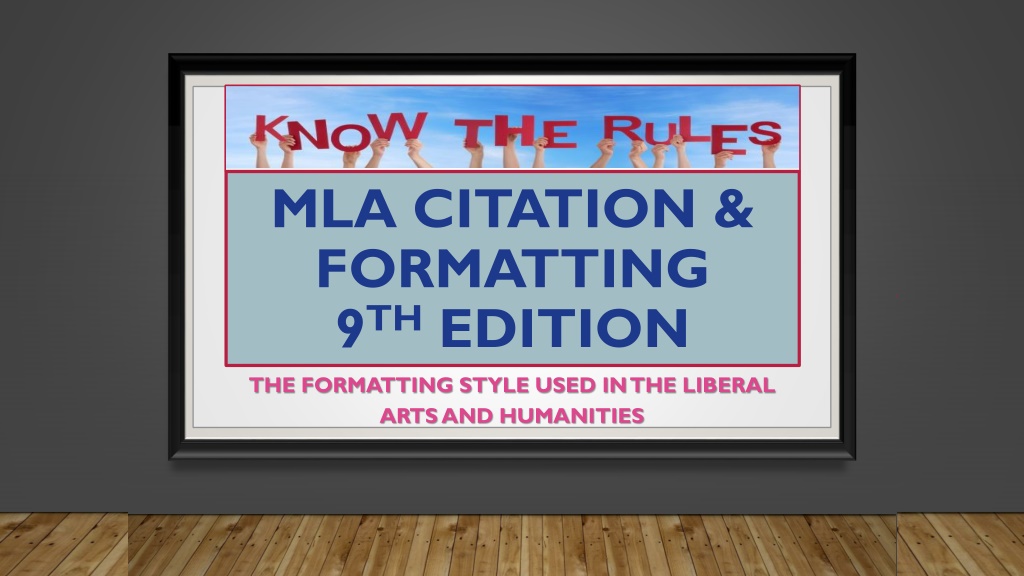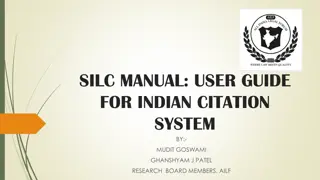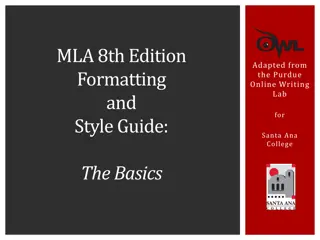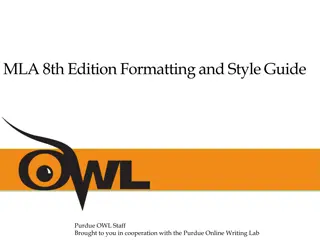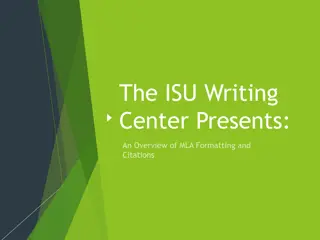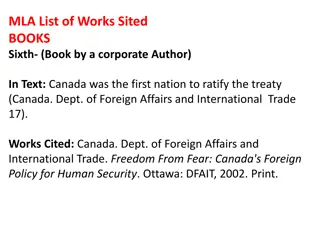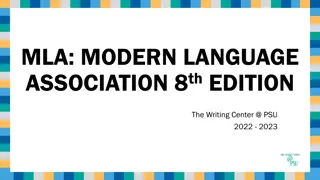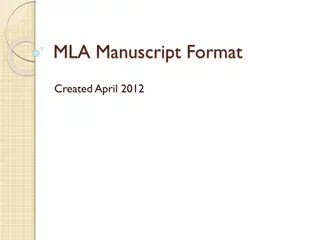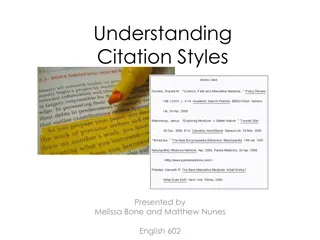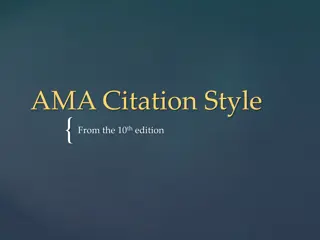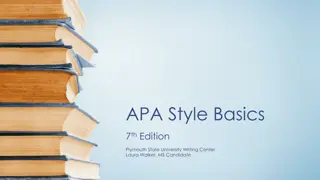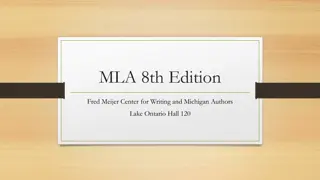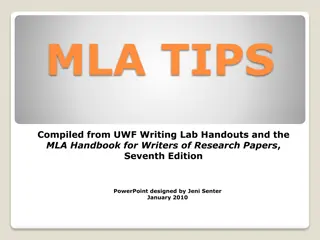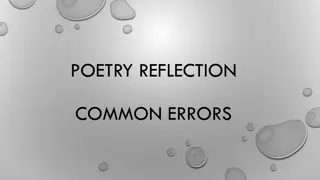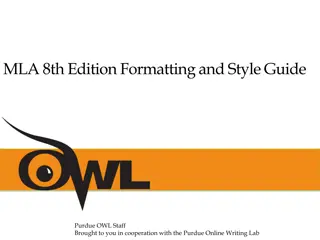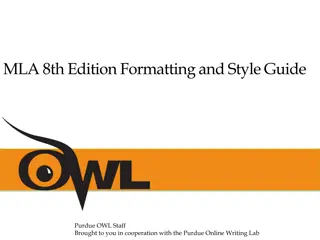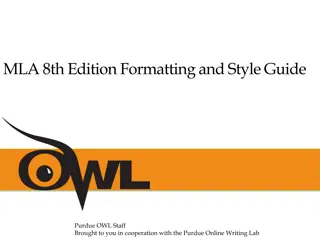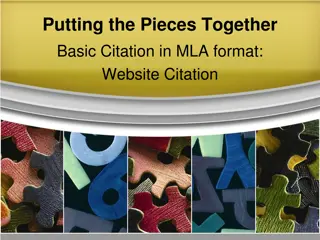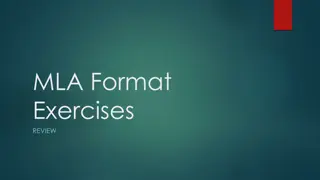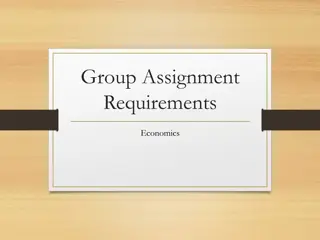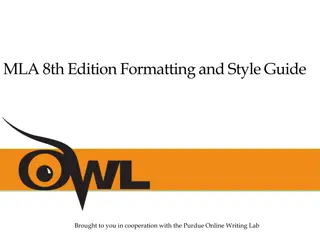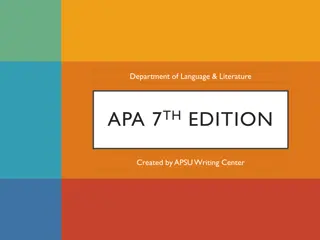MLA Citation and Formatting: Guidelines for Research Papers
Explore the latest MLA 9th edition guidelines for formatting research papers in the liberal arts and humanities. Learn about key elements, citation practices, and general formatting rules such as margins, fonts, and spacing. Understand how to create a properly structured document from rough draft to final draft, including citing within text and compiling a Works Cited page.
Download Presentation

Please find below an Image/Link to download the presentation.
The content on the website is provided AS IS for your information and personal use only. It may not be sold, licensed, or shared on other websites without obtaining consent from the author. Download presentation by click this link. If you encounter any issues during the download, it is possible that the publisher has removed the file from their server.
E N D
Presentation Transcript
MLA CITATION & FORMATTING 9TH EDITION THE FORMATTING STYLE USED IN THE LIBERAL ARTS AND HUMANITIES
INFORMATION FOR THIS PRESENTATION WAS TAKEN FROM THE FOLLOWING SOURCES: THE ONLINE WRITING LAB (OWL) AT PERDUE UNIVERSITY: https://owl.english.purdue.edu https://www.youtube.com/watch?v=WoCYwIbf6e8 The MLA Handbook published by the Modern Language Association of America, New York, 2021 MLA Citation Guide: http://www.andyspinks.com/mla/
FROM ROUGH DRAFT TO FINAL DRAFT The most current MLA guidelines for formatting the final product can be found in the MLA Handbook for Writers of Research Papers, Ninth Edition which was released in April of 2021 The MLA Handbook is published by the Modern Language Association, the authority on MLA documentation style WE WILL NOW REVIEW THE KEY ELEMENTS OF THE DOCUMENTATION STYLE AS IT WILL BE USED BY YOU IN YOUR PAPERS
MLA ELEMENTS BROKEN DOWN: 1. The general format used for a document. 2. The format used for the first page of a document. 3. To cite or not to cite, that is the question. 4. How to cite within a text. 5. Inserting short and long quotations in a document. 6. Adding or omitting words in direct quotations. 7. A sample body paragraph. 8. The Works Cited page.
FORMAT: GENERAL GUIDELINES Type Type on white 8.5 x 11 paper Double- space Double-space everything Set all margins to 1 inch on all sides (this is the standard default on most word processors) Include a HEADER with your last name and page number with no punctuation in the upper right corner, half an inch from the top of the page Margins Header Use 12 pt. Times New Roman font (or similar font like Arial or Tahoma) and left-justify the body of your text Font Indent the first line of paragraphs one half-inch (tab one time) Indent
FORMAT: GENERAL GUIDELINES .continued Leave only one space after internal punctuation (commas, semi-colons, colons) and two spaces after closing punctuation (periods, exclamation points and question marks) Punctuation Use italics and proper capitalization for titles of works discussed Italics Ensure that the information provided in the in-text citation is identical to the resources found on the Works Cited page Citation info Print Print on one side of the page only
FORMATTING THE FIRST PAGE Create a header in the upper right corner at half an inch from the top and one inch from the right of the page (include your last name and page number; no punctuation) Double space everything In the upper left corner of the FIRST PAGE ONLY, list your name, your instructor's name, the course, and due date (in that order) all double-spaced **THE DATE SHOULD BE LISTED WITH NUMBER, MONTH AND YEAR WITH NO PUNCTUATION. FOR EXAMPLE; 13 January 2023 Centerthe title of the assignment (use standard caps, but no underlining, italics, quotes, or bold)
TO CITE OR NOT TO CITETHAT IS THE QUESTION Merriam-Webster s dictionary defines plagiarism as presenting someone else s ideas , information, expressions or entire work as one s own. When you plagiarize, you appear dishonest and ignorant. Even if you only borrow a few words from an author without properly citing them, you are still plagiarizing.
We dont expect you to know everything in high school, but we DO expect you to use relevant information in your work. Sometimes, this includes using someone else s research or knowledge to support your ideas and then citing their work!! In summary . IN HIGH SCHOOL, NOBODY EXPECTS YOU TO BE AN EXPERT, BUT WE DO EXPECT YOU TO PROPERLY CITE THE EXPERTS!!
IN-TEXT CITATIONS: THE TWO BASIC PARTS MLA USES PARENTHETICAL CITATIONS WHICH INCLUDE TWO COMPONENTS: 1. THE IN-TEXT CITATION: Whenever a work is cited (referred to in any manner), credit must be given to the author of the work immediately following the borrowed information, whether the information is paraphrased or quoted directly. Failure to do so is PLAGIARISM - literary theft - and comes with serious penalties!! II. THE WORKS CITED PAGE: The source must also be cited thoroughly at the end of the assignment, in the Works Cited, which is included on a separate page at the end. All cited works must be listed in alphabetical order (by author s last name) on this page. Formatting for each source may change depending on the type of source used. Refer to your MLA Citation Guide (which can be found on the Iona website under Library Links )for specific information.
THE IN-TEXT CITATION.: IF THE AUTHOR IS MENTIONED IN THE TEXT: In the story, Dahl initially describes Mary Maloney as a housewife who loved to luxuriate in the presence of this man (263). JUST INCLUDE THE PAGE, AUTHOR NOT REQUIRED IF THE AUTHOR IS NOT MENTIONED IN THE TEXT: Early in the story, Mary Maloney is described as a housewife who loved to luxuriate in the presence of this man (Dahl 26). AUTHOR AND PAGE REQUIRED FOR ONLINE RESOURCES: Include in the text the first item that appears in the Works Cited entry that corresponds to the citation (ie. author name, article name, website name, film name). ------------------------------------------------------------- CORRESPONDING WORKS CITED ENTRY (to be included at the end of the paper, on a separate page): Dahl, Roald. Lamb to the Slaughter . Lamb to the Slaughter and Other Stories, Penguin Publishing, 1995, London.
INCLUDING SHORT QUOTATIONS..... If a quotation is four lines or less once it is typed, it is considered a short quotation. It is to be included in line with the rest of the information in the paragraph and introduced with appropriate punctuation - usually a comma - unless it is part of the sentence (as below). The parenthetical documentation is to follow immediately afterwards along with closing punctuation. CONSIDER THE QUOTATION FROM THE PREVIOUS SLIDE AS AN EXAMPLE OF A SHORT QUOTATION: Maloney is described as a housewife who loved to luxuriate in the presence of this man (Dahl 26). She seems to exist entirely for her husband. Dahl creates the image of a doting wife in his initial descriptions. Early in the story, Mary *THE SECOND PART, THE WORKS CITED ENTRY, WOULD BE ON THE WORKS CITED PAGE*
LONG QUOTATIONS If the quoted text is more than four lines typed, it is considered a long quotation and should be separated from the paragraph (without quotation marks) and the entire quotation should be indented by one inch (2 tabs) or blocked. It should be double-spaced like the rest of the assignment. Review the example which follows. In the short story Lamb to the Slaughter , despite Mary s attention to all his needs, Patrick Maloney treats her poorly, essentially abandoning her, saying : note the opening punctuation This is going to be a bit of a shock to you, I'm afraid ..But I've thought about it a good deal and I've decided the only thing to do is tell you right away. I hope you won't blame me too much .I know it's kind of a bad time to be telling you, but there simply wasn t any other way. Of course, I'll give you money and see you're looked after. But there needn t really be any fuss. I hope not anyway. It wouldn't be very good for my job. (Dahl 26) (note the punctuation before the parenthetical documentation)
ADDING/OMITTING WORDS IN-TEXT EXAMPLE FOR ADDING WORDS (use square brackets): [Piggy] smeared the sweat from his cheek (Golding 3). IN-TEXT EXAMPLE FOR OMITTING WORDS (use ellipses): In an essay on urban legends, Jan Harold Brunvand notes that "some individuals make a point of learning every recent rumour or tale . . . and then share the lively details with several people as though they were true" (78).
TOPIC SENTENCE A SAMPLE BODY PARAGRAPH One of the elements used effectively in the story Lamb to the Slaughter , is irony. Early on, Dahl introduces the protagonist, Mary Maloney, as a gentle, doting wife who seemingly lives to make her husband, Patrick, happy. As Mary awaits Patrick at the end of the day, Dahl describes her, stating, she would glance up at the clock, but without anxiety, merely to please herself with the thought that each minute gone by made it nearer the time when he would come. There was a slow smiling air about her, and about everything she did .For her, this was always a blissful time of day (26). Mary is depicted as a dependent woman whose happiness seems to be tied entirely to the man she loves. However, as the story progresses and Patrick tells Mary that he will be leaving her and that she shouldn t make a fuss, Mary cannot believe it. When he speaks rudely to her, she clubs him over the head with a frozen leg of lamb, killing him. She then proceeds to get herself an alibi, to ingratiate herself to the investigators as the mourning widow, and ends up cleverly feeding them the murder weapon. As they enjoy their lamb dinner, Dahl writes, in the other room, Mary Maloney began to giggle (27). Not only does Mary kill Patrick, but she thinks it is funny that none of the officers suspect her. The sweet, doting wife that Dahl describes early on, gets away with murder because nobody expects that such a gentle soul could be guilty of cold-blooded murder; thus, an excellent example of irony. POINT 1 EXPL D PROOF 1 INTRO D & CITED COMMENT 1 & CONN. TO ARG. POINT 2 EXPL D PROOF 2 INTRO D & CITED COMMENT 2 & CONN. TO ARG. CLOSING SENTENCE
THE WORKS CITED PAGE At the end of the document, on a separate page (in alphabetical order by the author s last name), list the works cited in creating the document. 1. Give the page the title Works Cited and center the title at the top of the page applying standard capitalization rules; this page still has a Header. 2. All listings should be double-spaced, with no extra spaces in between listings. The second and subsequent lines of each item should have a hanging indent (tab one time). 3. List and format all sources cited by referring to the MLA Citation Guide which can be found in the library and on the school s website. An example of a Works Cited page will follow.
THE LIST OF WORKS CITED (9TH EDITION) In the current model, the work s publication format is not really considered. Instead of asking, How do I cite a book (or video or web page)? , the writer creates an entry by consulting the MLA s list of: CORE ELEMENTS (the facts common to most works) which are assembled in a specific order as seen in the following slide .
CORE ELEMENTS: Each entry on the list of works cited iscomposed of facts which are common to most works the MLA CORE ELEMENTS. They are assembled in a specific order, using the punctuation outlined. Not all the elements apply to all works. On the following slide, there is a clear explanation of each element.
1. Author. *the primary creator of the resource referenced (last name, first name) 2. Title of Source. *the title of self-contained source, or title of a part of a larger whole 3. Title of Container, *the title of the larger whole that contains the source (in italics) 4. Contributor, *refers to editors, translators, adaptors, illustrators, etc. 5. Version, *if the source was released in more than one form or edition (ie. MLA 9th Edition) 6. Number, *if the source is issued in multiple volumes or issues (or seasons) 7. Publisher, *organization responsible for producing the source (bottom of home pg on website) 8. Publication Date, *when the version you used was published (could be a year, day/month, season, range) 9. Location. *refers to page numbers for print sources (no specific pages required for novels; URL s for online sources -- use full URL's and include http:// or https:// accordingly) BE SURE TO INCLUDE THE DATE ACCESSED AT THE END FOR ONLINE WORKS
SAMPLE WORKS CITED ENTRIES USING 9TH EDITION MLA Here are possible entries and how they should appear on a Works Cited page; a song, a novel, an online article, a short story, and a website (in that order):
FINAL RULE: ALWAYS FOLLOW YOUR INSTRUCTOR S GUIDELINES!
